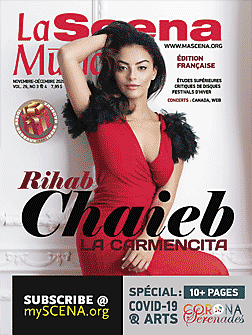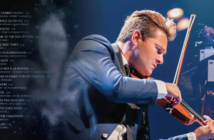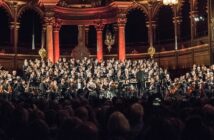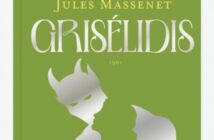
This page is also available in / Cette page est également disponible en:
![]() Francais (French)
Francais (French)
In the space of a single-page survey, it would be impossible to give a comprehensive overview of Beethoven’s Ninth Symphony on record, so we will devote the following lines to some of the more outstanding versions on disc, both old and new.
Among those of older vintage, Wilhelm Furtwängler´s 1951 performance and Arturo Toscanini’s a year later are benchmarks. While the first of these took place at the Bayreuth Festival at its re-opening six years after the end of World War II, the second is part of the 85-year old conductor’s late-life undertaking of committing the complete cycle of Beethoven’s symphonies to disc.
Furtwängler’s reading is larger than life, both mysterious and solemn, like a cathedral of sound marked by constant shifts in tempos, the conductor electing to stress some passages for greater expressive effect. In the third movement, for instance, the music almost grinds to a halt in one spot; as it teeters on the edge of silence, the musicians are put to the test, the brass in particular, who have to sustain the sound to a point of almost running out of breath. We are there, in the midst of a formidable sound construct, full of solemn moments, notably towards the end of the first movement, where brass and timpani thunder over the mysterious chords sustained by the strings.
Toscanini, in stark contrast, goes full throttle and never stops to rest. Rather than worrying over the music, he pushes it constantly. His charges have little time to sit back and take a breath because it is so unrelenting and energetic. The reading is precise, clear, fast-paced, but never rushed. Most importantly, it sings, as if Toscanini had finally succeeded in making do on that almost impossible feat of sustaining a high level of intensity while getting the orchestral sections to sing in the process.
Otto Klemperer’s live version, recorded in London in 1957, is magnificent in its own right. Paramount to him were beauty and emotion, achieved here in the very clarity of sound and his way of letting the instruments and orchestral sections play off each other. The tempo is measured throughout, and nothing is lost in the mix. There is some heaviness, but instrumental interactions ensure momentum. This version has a little more bite than his studio recording, the concert setting most likely being a factor.
In 1963, Herbert von Karajan produced his own Beethoven cycle, all of which have become reference recordings. The layers of sound are now clearer than ever thanks to the rise of stereophonic recording techniques. In contrast to Furtwängler’s orchestra, Karajan’s sounds much lighter, the conductor intent on creating a more voluptuous texture through perfect intonation of the woodwinds and brass, blended to a tee with the strings. If you are looking for rough edges in Beethoven’s music, Karajan is not your choice. His ideal was that of elegance, albeit at a cost in expression, as certain dissenting voices would contend.
In the 1950s, period instruments found their way into the public eye, first through Baroque music, then within the 18th- and 19th- century repertoires. This raises the question of how these instruments have affected the performance of music. One notable difference is the downsizing of orchestras from traditional symphonic strength; another relates to rhythm and its much livelier and contrasted treatment; a third is the lessening of string vibrato; a fourth is the lighter sound of the timpani, closer to that of a snare drum. In the beginning, these characteristics were not viewed favourably in certain circles who found them not opulent enough. Opinions have changed since, the quicker tempos now better appreciated for the sake of giving the music a livelier edge.
Of the recordings of the Ninth Symphony with period instruments, John Eliot Gardiner’s 1994 take with the Orchestre révolutionnaire et romantique stands out the most. The ensemble’s name is revealing in itself as it makes us understand that the performance of 19th century music on period instruments had finally come of age. It offers the best of two worlds, one edgy, contrasted, dramatic and dynamic (the latter in the string attacks), the other singing and lyrical, even grandiose.
The use of period instruments has even rubbed off to a degree on current performance practices. Beethoven’s symphonies are approached nowadays in a much lighter fashion, at faster tempos and in a more lively way. A case in point is the 1991 Royal Liverpool Orchestra release under Charles Mackerras: it is at once animated, imaginative and rhythmically charged. Ditto Kent Nagano in his fast-paced and luminous MSO readings issued on Analekta. That said, I do believe the Mackerras and Gardiner versions to be the defining recordings of the years leading up to the new century.
This surely invites the question of leading contenders to the title in our time. My selection would be the 2006 version of Osmo Vänskä and the Minnesota Symphony Orchestra. It is a good illustration of today’s concern about playing with precision, where motifs are brought to the fore across the whole orchestra in continuous and richly contrasted flow. I have never heard such clarity in the fugal development of the opening movement. Not only are the individual parts readily discerned, but each has its own vitality. The conductor has a discerning ear, seizing on details and drawing them out accordingly.
In this year marking the 250th anniversary of Beethoven’s birth, a listen to the Ninth Symphony is pretty well de rigueur. The composer spent a good part of his life on it and was adamant on incorporating Schiller’s Ode to Joy, a text that loudly proclaims the brotherhood of all men!
Translation by Marc Chénard
This page is also available in / Cette page est également disponible en:
![]() Francais (French)
Francais (French)














